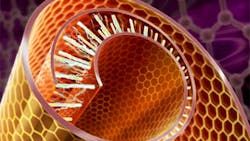Was there a time when you were introduced to the piezoelectric effect in one of your physics classes and wondered, “If piezoelectric crystals generate voltage when subjected to vibration, can’t we harness this voltage to power our electronics?” It was a pretty interesting afterthought. What about the voltage developed from the Seebeck effect?
Lots of naturally occurring temperature gradients exist in our environment, such as the thermal gradient between our bodies, the engines we use, even our gadgets and ambient temperature. It would feel wasteful to watch all of the energy from these potential sources dissipate to the empty void.
Apparently, such sources would only yield power just enough for the mobile phone of an ant. But recent developments in materials science as well as improvements in power consumption of modern electronics have aroused interest anew. Thus, in 2006, the first nanogenerator emerged, drawing energy through the piezoelectric and semiconductor characteristics of a vertically grown ZnO nanowire.
Nanogenerators, Why Not Microgenerators?
I’m just kidding. The answer to that should be trivial, and so should the term’s definition (microgeneration is a thing by the way). Nanogenerators (NGs) are generators that harvest energy from the environment for nanosystems. This scope has extended toward much larger systems with the advent of new discoveries and innovations.
In general, nanogenerators can draw energy from three known environmental sources: friction (triboelectric, where research seems to be most active today), shaking and vibrating (piezoelectric), and temperature gradients (thermoelectric/pyroelectric). I say three known sources just in case we find possible sources in the future (maybe cosmic/background radiation or that annoying EMI through teeny-tiny antennas).
Then again, drawing from a single source can be troublesome when the environment changes (the source stopped moving or the temperature of both sides reached equilibrium). To solve this, NGs have to draw on multiple sources. These NGs are now hybrid cells that can consist of a dye-sensitized solar cell and a piezoelectric nanogenerator in series.
What about storage? Aside from the traditional full-wave bridge rectifier, which demands a wasteful two-step conversion process (mechanical to electrical and electrical to chemical), a more efficient approach would be to use a self-charging power cell (cut down to a mechanical to chemical process). Without the drops on the diodes, a self-charging power cell would deliver more power to the storage unit. The only limitation I see is that the cell would always be charged (you can’t place a switch to cut off the charge path). Or am I oblivious to an alternative?
Let’s Put Nanogenerators Everywhere!
NGs look like the next big thing in renewable energy. But why can’t we see any of them on our Galaxy Tabs or iPhones or at the very least, digital watches? It could be one of several reasons: It’s still too uneconomical to manufacture them; the technology for mass production of the materials is still unavailable; many are still unwilling to invest on this kind of enterprise; the tech is too “new” and is still earning publicity; the overall power density delivered is insufficient for most mobile devices; and so on. I can personally attest to some of the latter reasons, though.
Specific nanostructures are hard to produce on particular compounds. They require an exacting chemical process under unique conditions that may be too alien to be quickly adapted by some manufacturing companies. This affects the hurdle on mass production. However, I’ve come upon journals lately with titles and abstracts that promise improvements in these areas. Simply do a search on nanogenerator efficiency and some are bound to come up.
The current capacity of NGs and even hybrid cells are too small, unless you want to walk around with a humongous bulk on your pocket sides. The maximum achieved ratings of NGs are quite far from the demands of our modern gadgets. I’ve worked on special low-power charging applications for certain phones and tabs, and they require a charging current of around 300 to 400mA at an input voltage of 4.2 V and above. Based on the figures, they’re not even enough to support battery charging at trickle or top-off. Not to be so pessimistic, NGs do have a place in sensors (they are for micro/nano systems after all). A popular field of interest involves the integration of NGs with biosensors and bioelectronics.
“Hello… Hello?” Oh, Battery is Dead. *shake* *shake* *shake*
In spite of all these obstacles, the future isn’t hopeless for NGs and mobile devices. If Moore’s law does not cease (some say until 2020), then mobile power consumption is bound to decrease continuously. The same goes for other low-power applications (depends on how creative you can get I guess).
Mr. Zhong Lin Wang, a pioneer in the field of nanogenerators, and his team at Georgia Institute of Technology introduced a smart, self-powered, self-cleaning keyboard in early February. They designed the keyboard in a way that would attract electrons when the user pushes down on a key, inducing current. Nanowires help amplify this effect by increasing surface area. With enough current, the simple typing action of the user would be sufficient to power the entire keyboard. I find this ingenious because the typing pattern of the user can also be extracted from the current waveform, providing a bonus security feature.
You can probably think of a plethora of other applications for NGs and hybrid cells. Where else would you want to see NGs being used?
References:
Harvesting the World's Mechanical Energy. (n.d.). Retrieved September 2015, from Georgia Tech.
This ‘smart’ self-cleaning keyboard is powered by you. (February 17, 2015). Retrieved September 2015, from Student Science: A Resource of the Society for Science & the Public.
Wang, Z. L., Chen, and Lin, Progress in triboelectric nanogenerators as a new energy technology and self-powered sensors. Energy Environ. Sci., 2250-2282, 2015.
Yoon, L., KAIST made great improvements of nanogenerator power efficiency (May 15, 2014). Retrieved September 2015, from EurekAlert: The Global Source for Science News.
Zhu, G., Chen, Zhang, Jing, & Wang, Radial-arrayed rotary electrification for high performance triboelectric generator. Nature Communications, 1-9, 2014.

